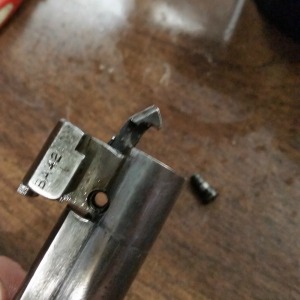Getting my own .303 was a dream come true. It’s a cartridge and rifle with a storied history and a pretty good performance, even by modern standards. What I was particularly looking forward to was the “buttery smooth” action I’ve heard so much about. But mine wasn’t. After removing a good deal of rust and gunk from this historic weapon, I headed down to the local service rifle club to have a shoot. The results were less than spectacular.
I didn’t have much ammo on me at the time, and was primarily going to shoot my SKS and M38, but I did want to put at least half a mag through my brand new (to me) No. 1 Mk iii SMLE. The rifle printed high and to the right, but still in a very tight group with the surplus CAC Mk 7 ammo I had on hand. The elevation was due to shooting at 100 yards with the 200 yard (minimum) setting, so I was fine with that, and it appeared the front sights were off a bit to the right. Not a major.

But getting those empty rounds out was difficult. I couldn’t stay in a shooting position and had to use two hands. My thoughts were it needed some cleaning after a long period of disuse. When I got home some quick research on the internet turned up a few that thought it could be due to fouling, so off I went to the garage to get some cleaning done.
One month later with a box of brand new Prvi Partizan .303 I went down to Taupo NZDA range to get the long guns out. After enjoying drilling tight groups with my Husky, it was a bit of a let down to pick up the Enfield and experience the same issues as before. I hadn’t changed the sights, but compensating worked fine. But still, every round was a real hard task to extract. My wife had a few shots and enjoyed the rifle, but didn’t enjoy the experience because of the tough-to-open bolt. I was crestfallen all the way back to Auckland, thinking I had managed to buy a dud surplus rifle.
What the issue actually was
So this time I took to cleaning with fervour. I disassembled the extractor and bolt face, gave everything a thorough degreasing and a light coat of Ballistol. Determined to not have the same issue again, I gave all of the bearing surfaces a generous application of oil and attempted to chamber a round. No problem. Extraction? Problem.
What?

This was beyond frustrating. I then took a closer look at the extractor claw and saw that it had become quite sharp after (many) years of use. So I undid the extractor screw, pulled the extractor claw out a bit (not all the way – that V-spring is a pain), and gave it a very light rounding off with a fine file. Extraction seemed to improve.
After three more delicate treatments like this, the bolt is now working like a charm. Now I’m actually looking forward to having a shoot with it again!
P.S. If you’ve got the same problem and want to try this fix, remember that you could damage your rifle – which as we all know can have serious consequences. Take it to a professional gunsmith if necessary.
Also, do not try chambering and extracting live rounds unless you are at a range, pointed in a safe direction. At all other times use a dummy round that you have made yourself, or buy a cheap practice round – they’re about $20 for two.











